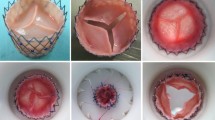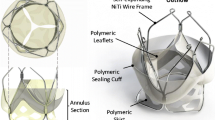Abstract
Background and purpose
Percutaneous heart valve replacement is an exciting growing field in cardiovascular medicine yet still with some major problems. Only sophisticated improvement of the instruments could make it a real alternative to conventional surgery. Therefore, the aim of this study was to evaluate different delivery devices for percutaneous heart valve replacement in vitro and in vivo.
Methods
A catheter prototype designed by our group, and two commercially available devices for the delivery of esophageal stents and aortic endoprostheses, were tested. After in vitro experiments, an ovine animal model of transfemoral pulmonary valve implantation was established using biological valved self-expanding stents. Only the delivery device for aortic endografts (Medtronic, Talent, Santa Rosa, CA, USA) allowed fast in vitro procedures without material fatigue. This device was chosen for the in vivo tests.
Results
Technical success was achieved in 9 of 10 animals (90%). One animal died after perforation of the ventricular wall. Orthotopic pulmonary placement was performed in 6 animals and intentional supravalvular valved stent placement in 3 animals.
Conclusions
An adequate in vitro model for this evolving field of interventional heart valve replacement is presented. Furthermore, the present study pinpoints the key characteristics that are mandatory for a delivery system in percutaneous pulmonary valve implantation. With regard to the delivery device’s ductility observed during this “venous” study, an approach to transfemoral aortic valve implantation seems feasible.








Similar content being viewed by others
References
Robicsek F, Harbold NB Jr, Daugherty HK, et al. (1988) Balloon valvuloplasty in calcified aortic stenosis: A cause for caution and alarm. Ann Thorac Surg 45:515–525
Cribier A, Eltchaninoff H, Bash A, et al. (2002) Percutaneous transcatheter implantation of an aortic valve prosthesis for calcific aortic stenosis: First human case description. Circulation 106:3006–3008
Bonhoeffer P, Boudjemline Y, Qureshi SA, et al. (2002) Percutaneous insertion of the pulmonary valve. J Am Coll Cardiol 39:1664–1669
Andersen HR, Knudsen LL, Hasenkam JM (1992) Transluminal implantation of artificial heart valves. Description of new expandable aortic valve and initial results with implantation by catheter technique in closed chest pigs. Eur Heart J 13:704–708
Pavcnik D, Wright KC, Wallace S (1992) Development and initial experimental evaluation of a prosthetic aortic valve for transcatheter placement: Work in progress. Radiology 183:151–154
Lutter G, Kuklinski D, Berg G, et al. (2002) Percutaneous aortic valve replacement: An experimental study. I. Studies on implantation. J Thorac Cardiovasc Surg 123:768–776
Huber CH, Tozzi P, Corno AF, et al. (2004) Do valved stents compromise coronary flow? Eur J Cardiothorac Surg 25:754–759
Boudjemline Y, Bonhoeffer P (2002) Steps toward percutaneous aortic valve replacement. Circulation 105:775–778
Chiappini B, Camurri N, Loforte A, et al. (2004) Outcome after aortic valve replacement in octogenarians. Ann Thorac Surg 78:85–89
Kolh P, Lahaye L, Gerard P, et al. (1999) Aortic valve replacement in the octogenarians: Perioperative outcome and clinical follow-up. Eur J Cardiothorac Surg 16:68–73
Florath I, Rosendahl UP, Mortasawi A, et al. (2003) Current determinants of operative mortality in 1400 patients requiring aortic valve replacement. Ann Thorac Surg 76:75–83
Edwards MB, Taylor KM (2003) Outcomes in nonagenarians after heart valve replacement operation. Ann Thorac Surg 75:830–834
Attmann T, Jahnke T, Quaden R, et al. (2005) Advances in experimental percutaneous pulmonary valve replacement. Ann Thorac Surg 80:969–975
Hanzel GS, Harrity PJ, Schreiber TL, et al. (2005) Retrograde percutaneous aortic valve implantation for critical aortic stenosis. Catheter Cardiovasc Interv 64:322–326
Lutter G, Ardehali R, Cremer J, et al. (2004) Percutaneous valve replacement: Current state and future prospects. Ann Thorac Surg 78:2199–2206
Coats L, Tsang V, Khambadkone S, et al. (2005) The potential impact of percutaneous pulmonary valve stent implantation on right ventricular outflow tract re-intervention. Eur J Cardiothorac Surg 27:536–543
Brandt M, Hussel K, Walluscheck KP, et al. (2004) Stent-graft repair versus open surgery for the descending aorta: A case-control study. J Endovasc Ther 11:535–538
Ferrari M, Figulla HR, Schlosser M, et al. (2004) Transarterial aortic valve replacement with a self expanding stent in pigs. Heart 90:1326–1331
Zhou JQ, Corno AF, Huber CH, et al. (2003) Self-expandable valved stent of large size: Off-bypass implantation in pulmonary position. Eur J Cardiothorac Surg 24:212–216
Bonhoeffer P, Boudjemline Y, Saliba Z, et al. (2000) Transcatheter implantation of a bovine valve in pulmonary position. A lamb study. Circulation 102:813–816
Ruiz CE, Iemura M, Medie S, et al. (2005) Transcatheter placement of a low-profile biodegradable pulmonary valve made of small intestinal submucosa: A long-term study in a swine model. J Thorac Cardiovasc Surg 130:477–484
Pavcnik D, Uchida BT, Timmermans HA, et al. (2002) Percutaneous bioprosthetic venous valve: A long-term study in sheep. J Vasc Surg 35:598–602
Sochman J, Peregrin JH, Pavcnik D, et al. (2000) Percutaneous transcatheter aortic disc valve prosthesis implantation: A feasibility study. Cardiovasc Intervent Radiol 23:384–388
Acknowledgments
G.L.’s project of percutaneous valve replacement is supported by the German Research Foundation, Bonn, Germany (Grant LU 663/4-1, LU 663/4-2). We thank Marion Frahm, Beata Hoffmann, Andrea Freistedt, Christian König, Florian Alten, and Andreas Bohlen who contributed to the in vivo experiments.
Author information
Authors and Affiliations
Corresponding author
Rights and permissions
About this article
Cite this article
Attmann, T., Lutter, G., Quaden, R. et al. Percutaneous Valve Replacement: Significance of Different Delivery Systems In Vitro and In Vivo. Cardiovasc Intervent Radiol 29, 406–412 (2006). https://doi.org/10.1007/s00270-005-0244-4
Published:
Issue Date:
DOI: https://doi.org/10.1007/s00270-005-0244-4




